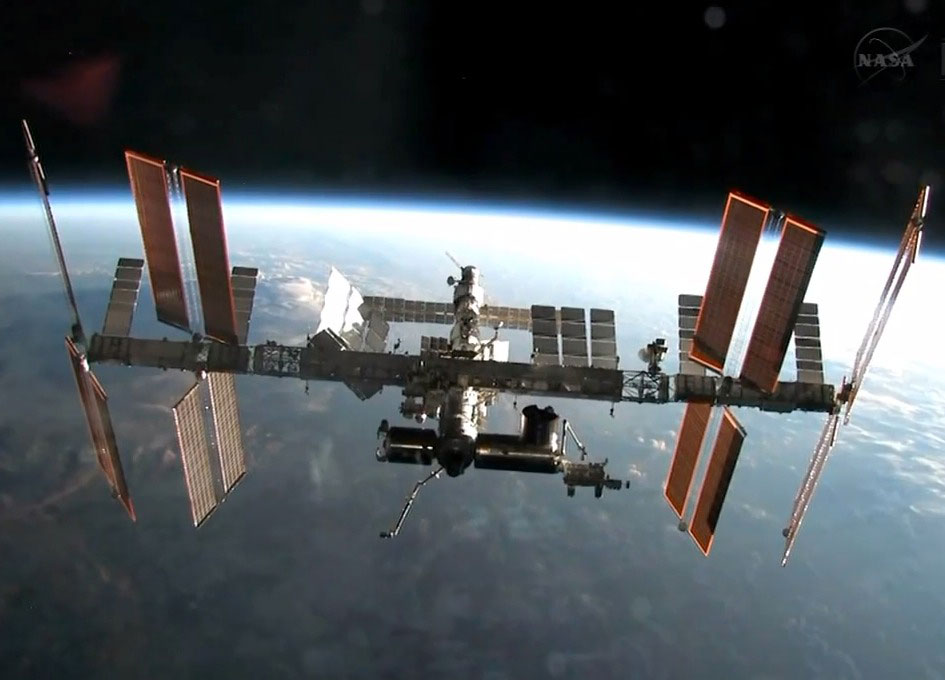NASA Space Station On-Orbit Status 25 August, 2020 – U.S. Segment Reopened

The Expedition 63 crew ended its stay isolated in the Russian segment of the International Space Station this morning after an extended leak test.
Mission Control also deployed remote teams to maintain 24/7 support for the station and its crew as Hurricane Laura approaches the Texas Gulf Coast.
Commander Chris Cassidy started the day reopening the hatches to the U.S. segment to begin resuming normal station operations. He reactivated U.S. life support equipment and restowed U.S. gear used during the crew’s weekend stay in the Zvezda service module.
Mission control will study the test data this week in an effort to determine the source of a cabin air leak detected in September of 2019. The rate is still well within segment specifications and presents no danger to the crew or the space station. The station’s atmosphere is maintained at a pressure comfortable for the crew members, and a tiny bit of that air leaks over time, requiring routine repressurization from nitrogen tanks delivered on cargo resupply missions.
Roscosmos Flight Engineer Anatoly Ivanishin spent the morning reconfiguring the Russian segment of the orbiting lab. The veteran station cosmonaut checked pressure valves and communications gear while opening hatches to various Russian modules.
Flight Engineer Ivan Vagner, on his first station mission, started the day resetting Russian life support equipment and sampling the air in Zvezda for analysis. Vagner also had time for science during the afternoon studying the Earth’s nighttime atmosphere and exploring ways to improve locating landmarks on Earth for photography.
Meanwhile, personnel at NASA’s Johnson Space Center in Houston are monitoring Hurricane Laura and making general preparations at the center. A small team of flight controllers germane to monitoring and sending commands for the most important station systems were sent to a backup control center hub in central Texas in advance of the storm.
A full team of station flight controllers is getting set up at the Marshall Space Flight Center in Huntsville, Alabama, to take over longer-term control of station systems should that become necessary. This backup activity is planned for each hurricane season or for some other extenuating circumstance and will be executed with no impact on critical station operations or the safety of the crew.
On-Orbit Status Report
Payloads
Spacecraft Atmosphere Monitor (SCRAM): The crew removed the MCA (Major Constituent Analyzer) plug from the SCRAM and powered it up. The MCA plug is used to protect the SCRAM’s sensor when the unit is powered off. SCRAM demonstrates the capabilities of a small, reliable, portable gas chromatograph mass spectrometer instrument aboard the ISS to conduct major and minor elements of air measurement (Nitrogen, Oxygen, Carbon Dioxide, Methane, Water, etc). The instrument transmits data back to the ground research team every two seconds, providing a continuous analysis to the ground research team. It has a mass of less than 9.5 kg, and consumes less than 40 watts of power in its nominal configuration.
Systems
ISS Leak Isolation Ops: The crew ingressed the USOS segment today after spending an extended weekend in the Russian Segment to allow ground teams to monitor module pressures. The crew closed several module hatches on GMT 234 as part of a leak isolation test. The Environmental Control and Life Support (ECLS) community has been tracking an increase in nominal atmosphere leakage since October 2019. The motivation for finding the leak is to reduce the amount of consumables required to maintain the ISS pressure. Following USOS ingress, the crew reactivated the Waste & Hygiene Compartment (WHC) for operations and restowed items that were transferred to the Russian segment during the USOS isolation period.
Completed Task List Activities:
None
Today’s Ground Activities:
All activities are complete unless otherwise noted.
Ground Support for USOS Ingress
MCC Swing to BCC Ops
Look Ahead Plan
Wednesday, 8/26 (GMT 239)
Payloads:
CIR-ACME Bottle Exchange
Systems:
Crew Handover Conference
Thursday, 8/27 (GMT 240)
Payloads:
CIR/ACME Configure for BRE
Food Physiology
GLACIER Desiccant Swap
Systems:
TOCA WRS Analysis/Data Record
Friday, 8/28 (GMT 241)
Payloads:
CIR-Hardware Return
MSRR/MSL SCA Exchange
Radi-N2 Deploy
Systems:
HMS AED Inspect
Today’s Planned Activities:
All activities are complete unless otherwise noted.
??? (Universal Bioengineering Thermostat). Checking ???-? No.07 thermostat temperature and unobstructed area near ???-? inlet/outlet vents
Combining RS and USOS volumes
Regeneration of Micropurification Unit (???) ?1 and ?2 cartridges
URAGAN. Earth imagery using still camera
USOS Ingress
DC1 + Progress 444 (76P) Hatch Opening
MRM1 Hatch Opening
PROFILAKTIKA-2. Health check of electro-pneumatic unit from [???-01-?] set
Galley Reactivation
Potable Water Dispenser Ambient Water Line Flush
Waste & Hygiene Compartment (WHC) Reactivation
Introducing updates to the Descent ODF and on Soyuz 745 Samsung PC
SM Atmosphere analysis using Freon Leak Analyzer/Detector (???)
USOS Item Transfer
Comm Configuration from MRM2
Connecting SM ??-??? PEV valves and MRM2 Pressure Relief Valves (???) control circuits, and MRM2 pressure control circuits from SM
Testing pressure equalization valves (PEV) and pressure relief valves (???); measuring pressure in [??] and SM ??? from EVA Support Panels (???) in MRM2
Spacecraft Atmosphere Monitor Power On
USOS Isolation Restow
VIZIR. Session with Photo image coordinate referencing – smart drawers system (????-??)
Transfer of kits with tubes for FGB from Node 1 to RS
Countermeasures System (CMS) Cycle Ergometer w/Vibration Isolation & Stabilization (CEVIS) Isolator Inspection
Air sample collection using Draeger tube air sampler (???) in SM for CO
Countermeasures System (CMS) Advanced Resistive Exercise Device (ARED) Cylinder Flywheel Evacuation
SM air sampling using ??-1? sampler
UF-ATMOSFERA. Hardware and electrical connections setup; PL Activation
Spacecraft Atmosphere Monitor MCA Plug Remove








